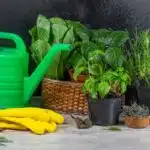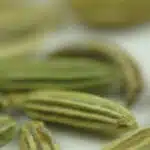“Gardening is a labor of love; with patience and care, you can reap a wonderful harvest.” Cilantro is an herb that offers a unique flavor to dishes and adds an aromatic flair to many meals. Growing cilantro in your garden or on your windowsill is relatively easy and requires minimal effort. In this article, we will explore how to grow cilantro plants and provide tips for harvesting and maintaining these special herbs.
If you love cooking with fresh ingredients, cilantro should be at the top of your list of must-have herbs. This bright green leafy herb has a distinct flavor that pairs well with many different dishes. Plus, it’s incredibly easy to grow! Cilantro thrives in full sun but can tolerate some shade as well. It does best in well-drained soil and doesn’t require frequent watering. With just a few simple steps, you can have plenty of fresh cilantro for all your recipes!
When growing cilantro from seed, start indoors 4-6 weeks before the last frost date in your region. Choose a potting mix or soil designed specifically for herbs and sow the seeds directly into individual pots or containers with good drainage. Once planted, water lightly every day until the seeds germinate – usually within 7-10 days – then reduce watering to once a week or when the soil looks dry on top. With some patience and care, you’ll soon have enough cilantro to add flavor to all your favorite dishes!
Selecting The Right Type Of Cilantro
Did you know that cilantro is one of the most widely-used herbs in the world? It’s no surprise then, that many people want to learn how to grow it at home. Selecting the right type of cilantro is a key part of this process.
When looking for the right type of cilantro, it’s important to pay attention to the seed packet or label. It should say ‘slow bolting’ or ‘long standing’ varieties on it. These types are slower to go to seed and will last longer in your garden. You can also look for organic seeds, as these are less likely to have been treated with chemicals which can affect your plant’s growth.
Once you have chosen your type of cilantro, you can move onto choosing the right location for planting. To ensure your cilantro plants get enough light and warmth, you should choose a spot that gets at least 6 hours of sunlight a day and is sheltered from strong winds.
Choosing The Right Location For Planting
Finding the ideal spot to plant cilantro can be like a match made in heaven. It’s essential that you take the time to select the perfect location, as this will directly influence your crop’s success.
When deciding where to plant your cilantro, consider sun exposure and soil quality first. Cilantro prefers full sun and well-draining soil, so choose a spot that gets at least six hours of sunlight every day and has good drainage capabilities. Additionally, cilantro doesn’t do well in overly wet or cold conditions, so if you live in an area with high humidity or cooler temperatures, opt for a sheltered area.
It’s also important to think about how much space you need for your plants. Your cilantro plants should be spaced at least eight inches apart from one another to ensure they have enough room to spread their roots and maximize growth potential. With all these factors taken into consideration, you’ll be ready to move on to preparing the soil for planting!
Preparing The Soil
In order to properly prepare the soil for cilantro plants, you’ll want to make sure it’s loose and nutrient-rich. If your soil is too compact or clay-like, consider adding compost or other organic matter to loosen it up. You can also mix in some high-quality fertilizer to provide the nutrients needed. It’s important to note that cilantro likes slightly acidic soil, so you may need to adjust the pH of your soil accordingly.
Another important factor when preparing a garden bed for cilantro is drainage. Poor drainage can lead to waterlogged roots, which can cause root rot and stunt your plants’ growth. To improve drainage, add coarse materials like sand or gravel in areas with particularly heavy soils. This will help ensure that your cilantro gets the oxygen and moisture it needs without becoming waterlogged.
Now that you’ve got your soil ready for planting, it’s time to get started! Make sure you choose a spot with plenty of sun exposure and good air circulation for best results. Then use a trowel or shovel to dig narrow holes about 6 inches apart, dropping two or three seeds into each one before covering them up with soil. As the seedlings begin popping up, thin them out so each plant has enough room to grow without overcrowding its neighbors.
Planting Cilantro
Many gardeners theorize that planting cilantro is a difficult task. But with the right steps, it’s actually pretty easy to grow this flavorful herb.
The first step in planting cilantro is to assess the soil. It should be well-drained and rich in organic matter such as compost or manure. If the soil needs more nutrients, add fertilizer according to its instructions. Once the soil is prepared, it’s time to plant the cilantro seeds or seedlings. Planting them in rows will make it easier to keep track of them as they grow. The seeds should be planted about one inch deep and spaced six inches apart from each other. For seedlings, space them out similarly but dig slightly deeper holes for them to sit in.
Watering is an important part of keeping cilantro plants healthy and promoting growth. Make sure the soil stays moist without becoming waterlogged by checking it regularly and adjusting watering schedules accordingly.
Water Requirements
As the old proverb says, ‘give a man a fish and you feed him for a day; teach a man to water his plants and you feed him for life.’ When it comes to growing cilantro, the importance of proper watering cannot be understated. With that in mind, let’s dive into the fifth step of how to grow cilantro plants: water requirements.
To begin with, cilantro is best grown in moist soil. To achieve this, one should water the plant once per week. Make sure to do it early in the day so that any excess moisture will evaporate before nightfall. It is also important to not over-water your cilantro, as this can lead to root rot and other problems. If you are unsure whether your cilantro needs more water or not, remember the age-old adage – when it doubt, don’t!
So there you have it – proper watering is essential for ensuring healthy growth of your cilantro plant! By providing adequate hydration each week and avoiding overwatering, you can ensure that your cilantro will continue flourishing for many years to come. Next up? Fertilizing!
Fertilizing
Fertilizing cilantro plants is an important step in the growth process. It’s like giving them a healthy boost of nutrients, providing them with the energy to thrive and reach their full potential. Just as a growing child needs balanced nutrition, so do these delicate herbs! Allusion aside, fertilizer should be applied at least once during the growing season.
When deciding which type of fertilizer to use, consider what kind of soil you have. If your soil is already rich in nutrients, a high-nitrogen fertilizer could be beneficial. Alternatively, if your soil has low nutrient content then a potash-based fertilizer may provide the best results. Be sure to read labels carefully and follow the specific instructions for application.
It’s also important to ensure the right amount of fertilizer is used; too much can overwhelm the plant and lead to stunted growth or yellowing leaves. Too little won’t provide enough nourishment and can stunt its development as well. Aim for a balance that will give your cilantro plants just what they need to flourish!
Thinning The Plant
Thinning the plant is an important step in ensuring healthy cilantro growth. Imagine a thick forest with lush trees, all competing for sunlight and water. If left unchecked, the crowded environment can stunt the growth of any one particular tree. The same concept applies to cilantro plants. To give your cilantro room to breathe and thrive, you must thin out its foliage periodically.
When thinning your cilantro plant, make sure to snip off any discolored or dying leaves and stems. This will help keep your plant healthy and pest-resistant by eliminating potential breeding grounds for disease-causing organisms. Additionally, this will allow more light and air to circulate through the plant so that it can continue to grow strong and vibrant without any competition from its neighbors.
Finally, be sure to leave some space between each stem so that new shoots have room to emerge. Doing this will ensure that your cilantro plant is well-balanced and has plenty of resources available for growing big and beautiful cilantro leaves! With regular thinning, you’ll be able to enjoy fresh cilantro year-round with minimal effort on your part. Moving onto controlling pests and diseases in your cilantro plants…
Controlling Pests And Diseases
Controlling pests and diseases is an essential part of growing cilantro. Pests can cause damage to the plant, while diseases can spread quickly and stunt the growth of your plant. To keep your cilantro healthy, check it regularly for signs of pests or disease.
Common pests that may affect cilantro include aphids, whiteflies, and spider mites. If you spot any of these on your plants, you can use insecticidal soaps or horticultural oils to kill them off safely. Additionally, planting companion plants such as nasturtiums or marigolds can help ward off pests from attacking your cilantro.
To prevent disease, avoid over-watering your plants and make sure there is proper air circulation around the plant. You should also rotate crops each season to ensure different families of vegetables don’t infect each other with disease. Taking these steps will help ensure that your cilantro remains healthy and productive throughout the season. With a bit of diligence, controlling pests and diseases doesn’t have to be a difficult task.
Once you’ve taken steps to protect your cilantro from invaders, it’s time to focus on harvesting it for use in the kitchen.
Harvesting Cilantro
Harvesting cilantro is an easy and rewarding process. Once the plant has grown to at least 8 inches tall, it’s time to start picking. You should cut off only what you need, leaving the rest of the plant to keep growing. This will ensure a continual supply of cilantro for your culinary needs.
When harvesting, be sure to cut just above a node on the stem as this will encourage further growth. If you’re picking a large amount of cilantro, you can use scissors or kitchen shears instead of hand cutting. Avoid bruising or crushing leaves so they retain their flavor. Freshly picked cilantro only lasts a few days in the fridge so it’s best to plan ahead when harvesting.
Once your harvesting is complete, it’s time to store your cilantro and make sure it stays fresh for as long as possible.
Storing Cilantro
Finally, storing cilantro is a breeze. Like a loyal companion, it will always be there when you need it. The best way to store cilantro is in the refrigerator. Keeping the leaves dry and in an airtight container will prolong its life. If you can’t use all the cilantro at once, you can always freeze it for later use.
To freeze the cilantro, first wash and dry it thoroughly. Then, chop it and place it into a plastic bag or container with a tight seal. When ready to use, simply thaw and enjoy! You can also opt to dry your fresh cilantro by hanging small bunches in a warm room away from direct sunlight until completely dry; then crumble or grind into flakes for future use.
Whether you decide to freeze or dry your cilantro, proper storage will ensure its freshness and flavor for weeks to come. An effortless way to make sure your herb garden doesn’t go to waste!
Common Problems With Growing Cilantro
As we come close to the end of our journey, it is important to acknowledge the potential pitfalls of growing cilantro. Common problems with this herb can be a major obstacle to cultivating a successful crop. It is like navigating a maze – one wrong turn and you’re back at the beginning again.
The most common issues with cilantro are aphids, fungus, and bolting. Aphids are tiny white insects that can cause stunted growth and distorted leaves while fungus can cause yellowing of leaves or wilting of stems. Bolting occurs when the plant matures quickly in warm temperatures, resulting in flowers instead of leaves.
Fortunately, steps can be taken to mitigate these problems with proper care and maintenance. This includes providing ample light for photosynthesis as well as keeping an eye out for pests and removing diseased plants immediately from the area. Regular watering and fertilization also helps ensure your cilantro will stay healthy throughout its growth cycle. With careful attention and dedication, these issues can be managed effectively so that you can enjoy your harvest for years to come!
By taking preventive measures such as these and understanding what challenges may arise, you can set yourself up for success when it comes time to companion plant your cilantro garden.
Companion Planting For Cilantro
Companion planting involves growing certain plants together to improve their growth potential. This method can be used when growing cilantro, which will benefit from the presence of other plants in the garden. There are a few herbs and vegetables that make good companion plants for cilantro, since they can help to enhance its flavor and even protect it from pests.
Carrots, parsley, radishes, and onions are all great companion plants for cilantro. Planting these vegetables close to or among your cilantro plants will help to keep away harmful insects and pests like aphids, cabbage worms, and spider mites. Carrots also tend to repel leafhoppers that can cause damage to the cilantro leaves. Planting marigolds near your cilantro is another great way to ward off unwanted insects as well as rabbits and deer.
Herbs like oregano, basil, thyme, sage, and dill are also good companions for cilantro. Not only do they provide flavorful additions to your dishes, but they can also increase the yield of your cilantro harvest by up to 20%. Plus, some of these herbs have properties that attract pollinators like bees which will help your cilantro flowers get pollinated more effectively. By incorporating companion planting into your gardening routine with cilantro you can ensure better yields and healthier plants overall!
With these tips in mind, you’ll be well on your way towards a successful harvest of flavorful cilantro every time. To get started on growing this delicious herb from seed follow our guide below…
Growing Cilantro From Seeds
Growing cilantro from seeds is a fun and rewarding activity. According to the National Garden Bureau, over one million households in the United States alone grow their own herbs. Cilantro is an easy plant to start with—it’s fast-growing and takes little effort to maintain.
When growing cilantro from seeds, it’s important to choose a good quality seed packet. The soil should be loose and well-drained, with plenty of sunshine or access to artificial light. Planting the cilantro seeds at least ½ inch deep will help them germinate faster. After planting, the soil must be kept moist throughout germination, which typically occurs within 7-14 days.
When caring for your cilantro plants, make sure not to over water them as they can quickly become waterlogged and rot. Regularly fertilizing your plants with organic matter like compost or manure will keep them healthy and happy. To ensure maximum growth potential, pinch off the tops of young plants when they reach 6 inches tall — this encourages bushier growth! With minimal effort, you’ll have a thriving crop of fresh cilantro in no time! Now that you’ve learned how to grow cilantro from seeds, let’s look into growing it indoors!
Growing Cilantro Indoors
According to the National Garden Bureau, cilantro is one of the most widely-cultivated herbs in the world. Growing cilantro indoors is an increasingly popular method for gardeners who want access to fresh, flavorful herbs all year round. In this section, we’ll discuss how to get your cilantro plants started and cultivating indoors.
When it comes to planting cilantro indoors, you’ll want to start with seeds or starter plants. If you’re purchasing starter plants, make sure they are healthy and not wilted in any way. Plant them at least 6 to 8 inches apart in a pot with well-draining soil and place the container in an area that receives plenty of light. Water regularly when the top inch of soil feels dry and ensure adequate airflow by keeping leaves dry by avoiding misting or overhead watering.
Cilantro needs a temperature between 65-80 degrees Fahrenheit to thrive, so if you live in a colder climate be sure to give your plant enough warmth. Additionally, supplementing light during periods of low sunlight can help keep your plant healthy and growing. With proper care and attention, you’ll have freshly harvested cilantro often! Troubleshooting tips for growing cilantro will help keep your plants lush and productive year-round.
Troubleshooting Tips For Growing Cilantro
Growing cilantro is like a dance; it takes practice and finesse to get the steps right. Knowing how to troubleshoot any issues that may arise can be the difference between a successful harvest or a failed crop. With these tips, you’ll have all the tools you need to grow cilantro with confidence.
One of the most common problems gardeners face when growing cilantro is bolting. This occurs when temperatures rise too quickly or remain consistently high, and the plant produces flowers instead of leaves. To avoid this, make sure you choose an area in your garden that receives partial shade during the hottest parts of the day and water regularly to keep soil moist.
Another issue you might encounter when growing cilantro is pests and diseases. To protect your plants from infestations, inspect them regularly for insects or signs of mold and mildew. If you do spot something, take action quickly by using organic pesticides or removing affected plants from your garden immediately. Additionally, rotating your crops every year can help reduce risk of pest infestations as well as disease outbreaks.
With these troubleshooting tips in mind, you should be well-equipped to tackle any challenges that come up during your cilantro-growing journey! With patience and perseverance comes success – so don’t give up if things don’t go quite as planned at first!
Frequently Asked Questions
What Is The Best Time Of Year To Plant Cilantro?
Gardening is a wonderful hobby to take up, and one of the most rewarding plants to grow is cilantro. With its fragrant leaves, it can add flavour and aroma to dishes and salads. But when is the best time of year to plant cilantro? Let’s have a look.
Growing cilantro in your garden requires some planning before you get started. Springtime is generally considered the optimal time for planting cilantro, as the warm temperatures will help stimulate growth. While you may be able to start sowing seeds in late winter, this can be tricky because of the possibility of cold weather setting in again and stunting growth.
Cilantro is an easy-to-grow herb that thrives with minimal effort, so if you plan your planting right you’ll be able to enjoy its delicious leaves all summer long! With a little bit of preparation and effort, you’ll be able to reap the benefits of growing cilantro in no time!
Can Cilantro Be Grown From Cuttings?
Cilantro is an herb that is popular in many cuisines, and it’s not hard to grow your own. But can cilantro be grown from cuttings? In this article, we’ll look at how you can use cuttings to propagate your cilantro plants.
Propagating cilantro from cuttings is a great way to get more plants without having to purchase seeds or seedlings. It’s important to ensure that the cutting you use has healthy leaves and stems. You should also make sure the cutting is from a healthy, mature plant—avoid using young, immature stems. Once you have a suitable cutting, dip it in rooting hormone and place the cutting in moist soil or water. Make sure the soil or water is kept moist during this time as the roots of your new plants will form quickly and easily.
Once the roots have formed and your new plants are established, you can transplant them into larger pots or into the garden bed. The best time of year to plant cilantro is usually in late spring or early summer when temperatures are warm but not too hot—this will help ensure your plants thrive throughout their growing season. With proper care and attention, you’ll soon be able to enjoy fresh cilantro from your very own garden!
How Much Sun Does Cilantro Need?
Growing cilantro is a great way to add some delicious spiciness to your meals. However, it’s important to know how much sun your cilantro needs in order to thrive. With the right amount of sun, you’ll be able to enjoy a healthy harvest of this delicious herb.
Cilantro plants need at least 6 hours of direct sunlight each day in order for them to grow strong and healthy. If you’re growing cilantro indoors, make sure it’s placed in an area that gets plenty of natural light, such as near a south-facing window. You can also supplement the light with grow lights or fluorescent bulbs if needed.
Make sure the soil is well-drained and that you water the plant regularly, but don’t overwater it. Cilantro prefers moist soil but not soggy soil. During hot weather, you may need to water more frequently so the plant doesn’t dry out. If you have cilantro planted outside, try using mulch around the base of the plant to help keep moisture in the soil and reduce evaporation from the sun’s heat.
By providing your cilantro plants with enough sun and proper care, you can ensure a successful harvest of flavorful herbs for all your favorite recipes!
Do I Need To Prune The Plant?
The lush and vibrant cilantro plant is like an oasis in a desert-a reminder of hope and growth. But can this paradise be maintained without pruning, or will it become an overgrown mess? To answer this, we must first understand how to properly care for our cilantro plants.
Pruning is an important part of caring for cilantro plants, as it encourages healthy new growth and helps keep the plant tidy. When pruning, it’s best to cut off the top third of each shoot at a 45-degree angle above a pair of leaves. This allows new stems with fresh foliage to grow from the base of the existing stem, resulting in denser foliage that looks better overall. Additionally, by removing any dead or discolored foliage, you can ensure your plant stays healthy.
Caring for your cilantro plant doesn’t end with pruning – you also need to make sure it gets enough sun and water. Cilantro prefers full sun and soil that is consistently moist but well-drained. Make sure your pot has holes in the bottom so excess water can escape and that you are providing just the right amount of sunlight and water for your plant’s needs. With proper care, your cilantro plant will thrive!
Can Cilantro Be Grown In Containers?
Growing cilantro in containers can be a great way to have access to fresh herbs year round. When it comes to growing cilantro, there are some considerations you should make before setting up your container garden. First, you need to find the right type of container for your plant. The pot should have ample drainage holes and be at least 10 inches deep with a wide enough circumference for the roots of the cilantro plant. You also want to make sure that it is made from a material that will not leach any toxic materials into the soil or water.
The next step is to select a good soil mix for your cilantro plants. A potting mix specifically designed for herbs is ideal, but if you can’t find one, then an all-purpose soil mixed with compost and perlite will work well too. You’ll want to make sure that the mix has plenty of nutrients and moisture so that your plants can thrive. Additionally, proper sunlight exposure is necessary for growing cilantro in containers; aim for 6-8 hours of direct sunlight per day.
Finally, once everything else is set up, it’s time to think about watering and fertilizing your cilantro plants regularly. Water when the top few inches of soil are dry, making sure you’re giving them enough but not too much. Fertilize about once every two weeks with a balanced fertilizer like fish emulsion or liquid kelp solution. With these tips in mind, you’re well on your way to having a thriving container herb garden!
Conclusion
Cilantro is a versatile and nutritious herb that can be grown all year round. It’s an easy plant to care for and can thrive in many different climates and environments. Despite its hardy nature, some simple tips and tricks can help you get the most out of your cilantro harvest. By planting at the right time, caring for it correctly, and making sure it gets enough sun, you can enjoy a flourishing crop of cilantro all year long.
The irony of it all? You don’t need to be an experienced gardener to grow cilantro successfully. In fact, even if you’ve never planted anything before, cilantro is a great introductory plant that will reward your efforts with delicious leaves and stems. So whether you’re a novice or an expert gardener, take the plunge and start growing cilantro today!
With just a bit of know-how, anyone can become a masterful cilantro grower – no green thumb required. With so many tasty recipes calling for fresh cilantro leaves or stems, there’s never been a better time to grow this fragrant herb in your garden. So get started now and discover the joys of growing your own cilantro plants!





























